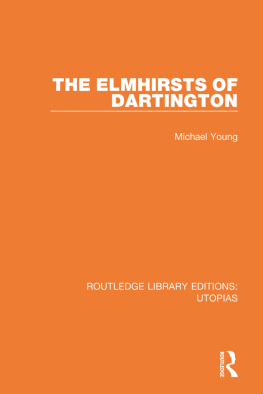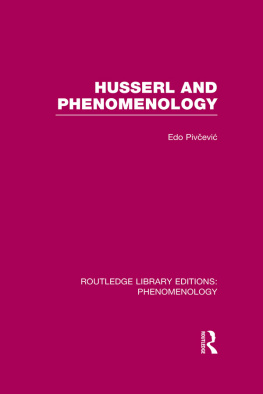First published in 1982 by Routledge & Kegan Paul
This edition first published in 2020
by Routledge
2 Park Square, Milton Park, Abingdon, Oxon OX14 4RN
and by Routledge
52 Vanderbilt Avenue, New York, NY 10017
Routledge is an imprint of the Taylor & Francis Group, an informa business
1982 The Dartington Hall Trust
All rights reserved. No part of this book may be reprinted or reproduced or utilised in any form or by any electronic, mechanical, or other means, now known or hereafter invented, including photocopying and recording, or in any information storage or retrieval system, without permission in writing from the publishers.
Trademark notice: Product or corporate names may be trademarks or registered trademarks, and are used only for identification and explanation without intent to infringe.
British Library Cataloguing in Publication Data
A catalogue record for this book is available from the British Library
ISBN: 978-0-367-35357-5 (Set)
ISBN: 978-0-367-85408-9 (Set) (ebk)
ISBN: 978-0-367-42361-2 (Volume 6) (hbk)
ISBN: 978-0-367-82386-3 (Volume 6) (ebk)
Publishers Note
The publisher has gone to great lengths to ensure the quality of this reprint but points out that some imperfections in the original copies may be apparent.
Disclaimer
The publisher has made every effort to trace copyright holders and would welcome correspondence from those they have been unable to trace.
CHAPTER 1
INTRODUCTION
People often ask if a boarding school, why an estate? If a well-run estate, why a school? Or an arts department?
Faith and Works , 1937
Visitors coming for the first time can drive off the road from London at Buckfastleigh and miss altogether the first indication that they have arrived at Dartington. Only if they take their eyes off the car ahead will they notice a grim stone church standing on its own, with hardly a house in sight, as if some nineteenth-century ecclesiastical planner absent-mindedly stuck it down on paper without venturing out of his deanery; and only if they slow down sufficiently might they see, almost hidden by grasses, the small blue signpost leaning drunkenly to one side:
DARTINGTON HALL TRUST
COLLEGE OF ARTS
SCHOOL
Parking in the church car park and continuing on foot they will see a rounded hill topped by a collar of trees and then half a mile away over the top of the bank a sawmill gantry and by its side a box-like building, surely twentieth-century. White. In Devon old buildings are grey. On the left there is an old one in the right colour, very strung out. In the car park for that, labelled OLD POSTERN, are four orange kayaks and a boy pumping up tyres.
Through the trees to the right of the road, on an escarpment, stands another large building, looking from this distance like a very overgrown house except that it has a square clock-tower with a clock that always says twenty past ten. Not factory, nor office; it must be the school or the college. Fields of rich green are broken by sharp lines of red earth where one of the fields has been ploughed, the only animals Friesian cows like cardboard cut-outs with all their heads held down to the same angle against the grass, all pointing in the same direction. Men in Mini Metros and women with round faces on puttering Hondas, as they get up speed for the hill, force the pedestrians into the hedge. A small girl walks cautiously holding her violin case on the hedge side, away from the traffic.
Another architectural puzzle lies on the right-hand side, a little like a ship set in concrete, white again, with long slit windows almost the whole length of a wall, not to look out of because they are too high for that, but to let light in. Its size suggests luxury; so does the ostentatious absence of anything that could be thought of as decoration. Again, not a Devon style. This is an idea dating from the era when houses were machines for living in. Such machines were never cheap.
From the top of the hill, looking back, a distant silhouette of Dartmoor. Ahead the road forks before descending. Going one way there is a gate. Whatever is hidden behind it can only be approached on foot around the side of a stone pillar past a notice which says Trail Users. These are the Hall and Gardens. To return to the Cider Press please retrace your route. The garden, which is what it turns out to be, is an unusual one, in the shape of an immense irregular amphitheatre. Beyond the gate the ground falls away at first gently and then more precipitately, down a series of terraces like a stepped green waterfall. At the bottom is an expanse of lawn and, rising up again on the other side, more terraces leading to a line of soft grey buildings which are the focus from every point of view. With its high arched windows, this must be the Hall itself, flanked on the left by another church tower. The old drive is serpentine, following the contours, and so are the walks wherever they can escape from the pressure to straighten themselves to the command of the rectangular terraces and the buildings. William Kent, the landscape architect who made other gardens in other places, said that nature abhorred a straight line. This garden masks the hand of man. Come around any corner, sit on any of the many garden seats, and there again are the buildings seen through a lace-work of tree branches, over the tops of magnolias or around the sides of rhododendrons. On a fine day in summer the garden is peopled, by a man with a whirring motor mower, boys with bamboo rakes shaped like fans, other boys with yellow plastic tanks on their backs spraying ground elder with weed-killer, visitors moving slowly along the many paths, and what are presumably college students rehearsing plays or practising dances.
* This and all other numbers in the text refer to the sources and notes listed at the end of the book.
The verticals are the abundant trees. A garden of trees as much as of plants on the top terrace gnarled Spanish chestnuts, their trunks strengthened with pitch; four tall London planes stepping down the other terraces; a statuesque Monterey pine; an evergreen oak with skirts as enclosing as a hovercrafts. The dominant colour, green, is all the more pervasive because there are so many shades of it. Other colours are in clumps, cherries in the spring, then azaleas and magnolias, rhododendrons later, then roses and hydrangeas, always planted together. One colour alone is constant through the seasons, the bright red of the flag which flies above the Hall. The wire snapping against the flagpole in the wind sounds from all over the garden like a giant jackdaw.
It is hardly a surprise in such a place to find so much sculpture: a half-reclining woman looking out over the garden with Henry Moores mark on her, a statue of Flora bearing a plaque For Leonard and Dorothy Elmhirst from the Community of Dartington on Foundation Day 1967, two granite swans and a bronze donkey, a small semi-circular temple rather like a mausoleum engraved with the names of all the Trustees at the time it was built.







